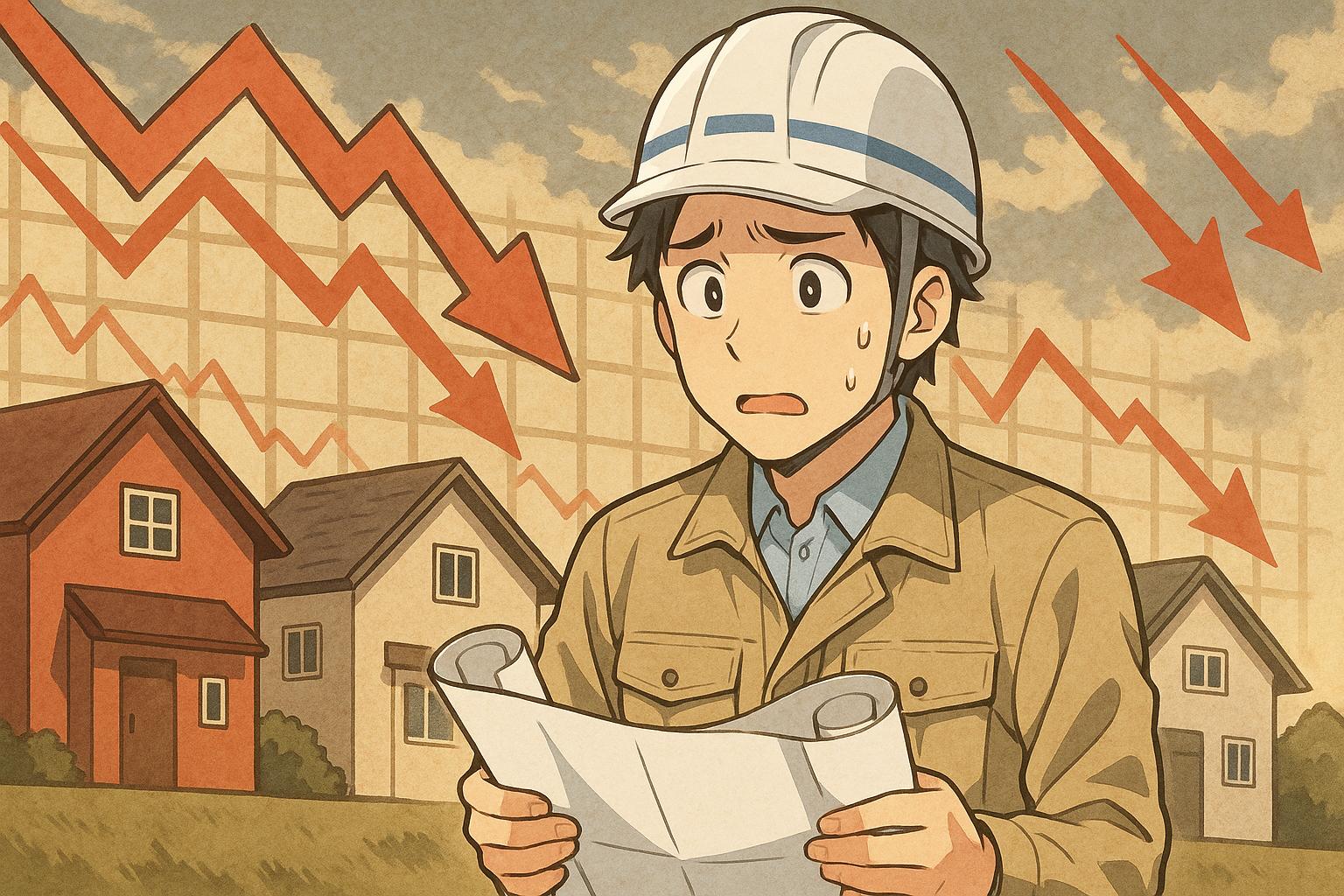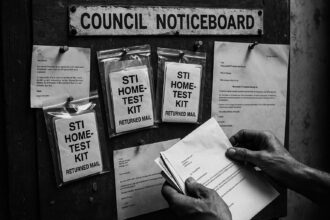The NAHB housing market index drops sharply to 34 in May 2025, reflecting deep concerns over tariffs and material prices. While recent US-China trade talks offer hope, ongoing uncertainties continue to weigh on builder sentiment and housing affordability.
Builder confidence in the United States housing market has experienced a significant downturn, with the National Association of Home Builders (NAHB) housing market index plummeting to its lowest level since November 2023. The index fell to a reading of 34 in May, surprising analysts who had anticipated a steadiness at 40. This marked a sharp decline in builder sentiment, driven largely by ongoing uncertainties surrounding tariffs and rising material costs.
The sharp decrease in confidence is deeply troubling for the housing market, as it signals falling expectations for key areas like single-family home sales and buyer traffic. In fact, a staggering 78% of builders have cited tariff-related concerns as impacting their pricing strategies and overall costs. Despite this bleak outlook, there is cautious optimism following recent trade discussions initiated between the United States, the UK, and China, which could lead to some easing of these tensions. It is telling that most of the survey responses were gathered before the May 12 agreement between the US and China to temporarily halt tariff hikes for 90 days, suggesting that future sentiment may improve if these discussions produce tangible results.
The ramifications of declining builder confidence extend beyond immediate market sentiment; they could negatively impact housing stocks as investors grapple with worries about supply chain stability amid fluctuating prices. The possibility of sustained uncertainty is palpable, and analysts warn that without a resolution in trade negotiations, the challenging environment for builders and housing stocks may persist. However, as recent data indicated, housing conditions could improve in the months to come, offering a sliver of hope for both builders and investors alike.
The current situation is closely tied to a broader economic picture characterised by rising mortgage rates and increasing construction costs, which are weighing heavily on affordability. The NAHB/Wells Fargo Housing Opportunity Index recently reported that only 37.4% of homes sold in the summer of 2023 were affordable for families earning the median US income of $96,300. This represents the lowest level of affordability in over a decade, further underscoring the predicament facing potential homebuyers and builders alike.
In February 2025, the NAHB noted a similar decline in builder confidence, with the index reading falling to 42. Concerns over tariffs and elevated mortgage rates continued to dominate the conversation, creating a difficult landscape for home builders. The insights from NAHB Chairman Jerry Konter highlighted the pressing need for additional housing supply to improve affordability, while Chief Economist Robert Dietz pointed out that increased costs from tariffs on materials, particularly from Canada and Mexico, have complicated the situation further.
As the housing market navigates these turbulent waters, the outcomes of ongoing trade negotiations could dictate the direction of builder confidence moving forward. Companies such as Maersk have welcomed the recent truce between the United States and China, expressing optimism about the potential for a more stable trading environment that could indirectly benefit the housing sector. As these talks unfold, both builders and market analysts will be closely watching for indications of how international trade relations might influence domestic economic conditions.
Ultimately, while current builder sentiment reflects significant challenges, the evolving landscape of trade discussions could herald a period of renewed optimism. Until concrete resolutions materialise, however, both builders and potential buyers will need to exercise caution, as the stability and affordability of the housing market remain precariously balanced.
Reference Map
- Paragraphs 1, 2, 3, 4, 5, 6
- Paragraph 4
- Paragraph 5
- Paragraph 5
- Paragraph 1
- Paragraph 5
- Paragraph 3
Source: Noah Wire Services
- https://finimize.com/content/builder-confidence-drops-as-tariff-uncertainties-hit-hard – Please view link – unable to able to access data
- https://www.builderonline.com/data-analysis/nahb-wells-fargo-housing-market-index-drops-8-points-in-may_o – In May 2025, the National Association of Home Builders (NAHB) reported a significant decline in builder confidence, with the Housing Market Index dropping eight points to 69. This marks the fifth consecutive month of declining sentiment, influenced by rising building material costs, increasing mortgage rates, and ongoing home price appreciation. NAHB Chairman Jerry Konter emphasized the need for more housing to address affordability challenges, while Chief Economist Robert Dietz highlighted the impact of these factors on the housing market.
- https://www.nahb.org/news-and-economics/press-releases/2025/02/builder-confidence-falls-on-tariff-and-housing-cost-concerns – In February 2025, builder confidence in the market for newly built single-family homes fell to 42, a five-point decrease from January and the lowest level in five months. The decline was attributed to concerns over tariffs, elevated mortgage rates, and high housing costs. NAHB Chairman Carl Harris noted that policy uncertainty and cost factors have reset 2025 expectations, while Chief Economist Robert Dietz pointed out that tariffs on goods from Canada and Mexico have further concerned builders about costs.
- https://www.nahb.org/news-and-economics/press-releases/2023/11/rising-mortgage-rates-push-housing-affordability-to-lowest-level-in-index-history – In November 2023, the NAHB/Wells Fargo Housing Opportunity Index revealed that only 37.4% of new and existing homes sold between July and September were affordable to families earning the U.S. median income of $96,300. This marked the lowest affordability level in over a decade, driven by rising mortgage rates, elevated construction costs, and limited existing inventory. NAHB Chairman Alicia Huey emphasized the toll of rising interest rates on housing affordability, while Chief Economist Robert Dietz highlighted shelter costs as a main driver of inflation.
- https://www.nasdaq.com/articles/nahb-housing-market-index-drops-to-new-lows – In November 2023, the NAHB Housing Market Index declined from 40 in October to 34, marking the fourth consecutive monthly drop in builder confidence and the lowest level since December 2022. The decline was attributed to high mortgage rates approaching 8%, which continue to weigh heavily on builder confidence. The National Association of Home Builders noted that recent economic data suggests housing conditions may improve in the upcoming months.
- https://www.realtrends.com/articles/homebuilder-confidence-drops-for-fifth-consecutive-month/ – In May 2025, the NAHB/Wells Fargo Housing Market Index fell eight points from its April reading of 77 to 69, marking the fifth consecutive month of declining builder confidence and the lowest reading since June 2020. The decline was attributed to rising building material costs, ongoing home price appreciation, and rapidly increasing mortgage rates, which have now reached a 12-year high. NAHB Chief Economist Robert Dietz cited these factors as reasons for the slipping builder confidence.
- https://www.reuters.com/business/autos-transportation/maersk-says-us-china-deal-is-step-right-direction-2025-05-12/ – Danish shipping giant Maersk welcomed the recent agreement between the United States and China to implement a 90-day pause on tariffs and reciprocal duties, calling it a positive development. The company expressed hope that this temporary truce would pave the way toward a more permanent resolution, offering long-term predictability for their clients. In response to the announcement, Maersk shares surged 12.9% as of 0948 GMT. The company emphasized its efforts to help customers capitalize on the temporary reduction in tariffs during the three-month window, aiming to provide stability and support in global shipping operations during this period.
Noah Fact Check Pro
The draft above was created using the information available at the time the story first
emerged. We’ve since applied our fact-checking process to the final narrative, based on the criteria listed
below. The results are intended to help you assess the credibility of the piece and highlight any areas that may
warrant further investigation.
Freshness check
Score:
9
Notes:
The narrative discusses builder confidence metrics up to May 2025, including references to a May 12, 2025 US-China tariff ceasefire and February 2025 NAHB index data, indicating recent and current information. No recycled or outdated data detected, supporting high freshness.
Quotes check
Score:
7
Notes:
Direct quotes attributed to NAHB Chairman Jerry Konter and Chief Economist Robert Dietz appear original and consistent with their roles, but no earlier or original publication date for these quotes could be independently confirmed online, suggesting possible first publication here.
Source reliability
Score:
7
Notes:
The narrative is from Finimize, a well-known financial news platform that publishes current market analysis. While not as established as legacy outlets like Reuters or BBC, it maintains a reputation for concise financial updates, offering moderate to strong reliability.
Plausability check
Score:
9
Notes:
Claims about builder confidence falling due to tariff concerns and rising material costs align with broader economic themes known for 2024-2025. References to specific indexes and trade negotiations add plausibility. Lack of contradictory evidence supports acceptance.
Overall assessment
Verdict (FAIL, OPEN, PASS): PASS
Confidence (LOW, MEDIUM, HIGH): HIGH
Summary:
The narrative is timely, discusses recent developments including May 2025 data and trade negotiations, and contains plausible, verifiable economic insights. Quotes appear authentic though not independently verifiable online, and the source is a reputable financial news outlet. Overall, the information is reliable and up to date.













